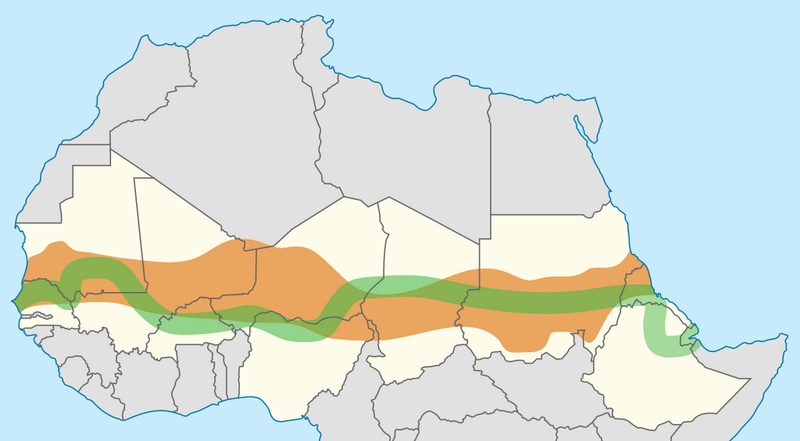
Last Updated on: 23rd May 2025, 03:13 pm
People sometimes think that I go out intentionally looking for good news. I don’t, really. But sometimes I happen across it. And sometimes, it is just a matter of seeing things that can be hopeful when they are viewed together.
I was thinking recently about the Great Green Wall of Africa. Whatever happened to it? I hadn’t heard much about it in over a year. Has it been abandoned?
For those who don’t know, the Great Green Wall of Africa is an attempt to stop the southward expansion of the Sahara Desert. The wall project stretches from Senegal, on the west coast, to Djibouti, on the east, covering a distance of something over 4,800 miles at a depth of perhaps five miles. The idea is to do a number of things to stop the rush of water to the sea and to stop the winds that dry things out.
I should mention that there are several other projects called the Great Green Wall. One is the Great Green Wall of China. There are other similar projects, either underway or proposed, elsewhere. These are mostly intended to restore deserts or to prevent their spread.
According to what I have found, the Great Green Wall projects are mostly not doing much. The one in Africa could be nearly at a stop, in danger of wars, needing funding, or lacking local interest due to whatever hardships are going on, according to the Wikipedia article.
Just as I was wondering about this, I got pushed in another direction. This time, it was a video about demi-lunes, which are also called “water bunds.” These are shallow semi-circular pits, dug into the earth on a gradual slope, with an open side facing uphill and a semi-circle on the downhill side. The soil excavated from them is on the downhill side, along the curve. The radius of the circle might be two meters or a little less. They are typically dug by hand. They are small swales that catch and retain water. The video, from Andrew Millison, shows the process. It is Inside Africa’s Food Forest Mega-Project. (Watch the video, if you want to have a jolt of hope.)
Water trapped in the demi-lunes is absorbed into the soil, where it does not run off or evaporate easily. This changes the nature of the soil, making it suitable to grow plants that can live in relatively dry conditions. Seeds are typically planted around them, including seeds of various types of trees. And these will thrive, with any luck, without any action aside from the little rain that falls in the area naturally.
The demi-lunes have been used for a long time. I hadn’t known of them when I first learned of the Great Green Wall, so they were new to me when I saw the video. The video speaks to the work that can be done, but as I watched it, I realized that it does not really address the deeper possibilities of such work.
I believe that the Great Green Wall of Africa can stop the Sahara’s movement to the south. It can, as the video says, provide rich land so millions of people can feed themselves. But more to the point, as it is brought to bear, it will have broader effects. In Africa, it can provide 4,800 miles of green belt that could cool the land, as it draws down carbon dioxide. Walls in India and China would have similar results. And there is more. In Australia, natural sequence farming could have a similar effect, if it comes into widespread use. Similar projects are already happening on small scales in the United States.
These projects might be able to have very positive effects on not just the food supply and the water supply, but on climate change. If enough of these projects are completed, I have no doubt whatever that they will have profound effects on our climate.
The Wikipedia article on the Great Green Wall of Africa casts some doubt on the condition of the project. It says that it was about 18% finished in 2023, and it needs about $33 billion of funding to be completed.
That figure struck me, as it relates to recent news. It was not long ago that I read that Elon Musk had lost $29 billion, in just one day. Think about that for a minute, and let it sink in. An amount of money, lost by one individual, in just one day, would be nearly enough to bring food and water security to millions of people. And not only that, with any luck it could have an enormous effect on the climate crisis, worldwide.
One other thing that would probably happen if Elon Musk decided to put his attention on the Great Green Wall of Africa, instead of bring a sledgehammer to such things as US healthcare. It is that his name could be rehabilitated. In fact, if he put up the money to finish the project in Africa, he might turn out to be the greatest man of the 21st century. I doubt it will happen. But then again, there are a lot of billionaires. Perhaps they will start competing to see who history will value most.
Illustration: Great Green Wall Map. Sevgart, Wikimedia Commons, CC-BY-SA 4.0.
Sign up for CleanTechnica’s Weekly Substack for Zach and Scott’s in-depth analyses and high level summaries, sign up for our daily newsletter, and/or follow us on Google News!

Whether you have solar power or not, please complete our latest solar power survey.
Have a tip for CleanTechnica? Want to advertise? Want to suggest a guest for our CleanTech Talk podcast? Contact us here.
Sign up for our daily newsletter for 15 new cleantech stories a day. Or sign up for our weekly one on top stories of the week if daily is too frequent.
CleanTechnica uses affiliate links. See our policy here.
CleanTechnica’s Comment Policy


